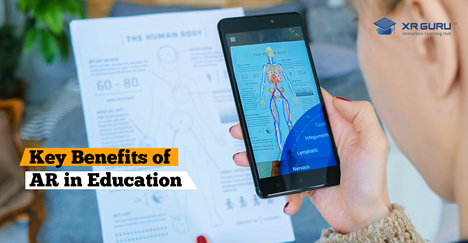Key Benefits of AR in Education

Only a decade ago, using technologies like Augmented Reality (AR) was expensive, and the market was devoid. However, many of us got to experience AR technology first-hand, thanks to games like Pokémon Go and social media apps like Snapchat. But the potential of AR is not confined to one field. AR technology can transform many industries, including education.
Amidst the COVID-19 pandemic, digitized education has taken over traditional learning, and more institutions have started to explore AR solutions to enhance the learning experience, making it fun and engaging.
The global market for AR in education is growing and is projected to reach $41.8 billion by 2027, according to a report issued by researchandmarkets.com
In this article, we highlight some of the key benefits of incorporating AR in education.
1. Immersive Learning Environment
Retaining the learner’s attention is one of the key hurdles in conventional education. However, interactive, gamified AR educational content can keep the students engaged throughout the lesson. Each class can be a different journey in the AR world. This keeps students motivated to participate actively in every lesson.
Since AR content is digital, it promotes collaboration. Teachers can spice up boring classes by creating interactive lessons where the students work together. It helps students to connect with the subject on a deeper level and improves teamwork.
2. Visualization
The power of visualization cannot be understated. Humans respond to visual data better than text, and a study by Thermopylae shows that humans process images 60,000 times faster than text.
Visualizing the subject matter improves retention power and helps learners to store the information for a prolonged period. Instead of looking at the diagram of a human brain in the textbook, students can view an augmented 3D model of a brain and visualize the left and right cerebral hemispheres and understand the different lobes in each cerebral hemisphere.
Interactive image projections can help students understand the concepts in less time and resulting in better exam scores.
3. Transforms Study Material
Augmented reality is capable of displacing paper textbooks and printed learning resources. With the help of AR, contents in a book can be transformed into interactive 3D models that give in-depth information. Augmented reality for education significantly reduces the cost of study materials and makes it easy to access from anywhere, anytime.
4. Practical Learning
One of the significant shortcomings of online education is the lack of practical elements. Incorporating AR in education can bridge the gap between online and real-life learning. Hands-on education extends an enhanced learning experience and helps the students understand the concepts clearly, in less time.
5. Safe and Efficient Training Environment
Augmented reality technology can come in handy for professional training. It is new to most people, so it will excite the learners to get in on the training program. You can provide a safe learning environment where the learners can practice and try new things without an element of risk or financial loss.
For instance, medical students can use AR applications to practice procedures and surgeries, eliminating the possibility of harming a patient and improving the quality of student training.
Takeaway Thoughts
We have just scratched the surface on the benefits of integrating AR technology in education. Augmented reality can transform the way we perceive education and help the students by providing an interactive platform that enhances the learning experience multifold.
"Imagination is the beginning of creation. You imagine what you desire, you will what you imagine, and at last, you create what you will. – George Bernard Shaw"
If you want to pique the imagination of students for a better future, AR is the way to go. With rapid technological advancements and the number of smartphone users increasing day by day, there has never been a better time to invest in technologies like AR.
Get in touch with us for a free consultation on your augmented reality learning needs
Claim Your Free Consultation



Comments
Post a Comment